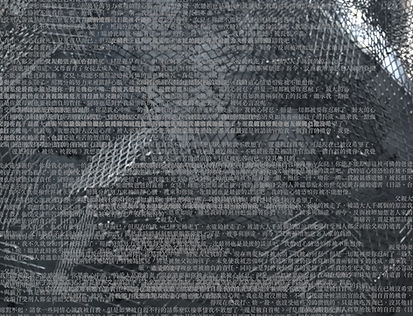
2020綠島人權藝術季
2020 GREEN ISLAND HUMAN RIGHTS ART FESTIVAL
5.15~9.15 白色恐怖綠島紀念園區
Green Island White Terror Memorial Park

張羽儀
CHANG Yu-Yi
北藝美術碩士生,關注人權議題,討厭不公平的事情。看到有人被欺負就想要把壞人揍爆。 2016年參與地下勞動合作社,2019組成Empty藝術團體。未來想透過藝術,成為超人。
《被》
-ed
2020 / 鐵、鍍鋅鋁、聲音裝置
2020 / iron, galvanized aluminum, voice-operated device
被,介詞,用在句中表示主角是受事者:他「被」殺了;用在動詞前,表示受動:被告、被失蹤。「被」指涉描述主體受害,但施暴的客體卻「隱形」的狀態。
在白色恐怖年代,被監禁的政治受難者,連唯一能對外表達感受的書信,亦被嚴格審查,信件甚至被塗改、被消失。許多冤屈與痛苦被噤聲,只能化為腦中的陣陣呢喃,等待探尋者的聆聽。
本作品試圖為壓迫體制下最邊緣的抵抗—政治受難者腦中的呢喃—發聲,透過將「被」字改編入他們遺留下的家書/遺書,錄製成語音檔案,置於大型鐵製裝置藝術中重複播放,被主流噤聲的無奈終於得以現身,控訴著持續但隱暱的加害體制。作品躲藏於獨居房角落的浴洗空間,那可能是在監禁生活中難得可以和自己對話短暫片刻;家書語音檔被層疊鐵網包裹於雲朵造型裝置中,象徵受難者靈魂、記憶失去歸屬的狀態,也引喻正義仍封印於雲端、未能被伸張;雲朵連結至小小的邊窗,腦中的呢喃成了在全面監控下僅有的一點被自由。
“-ed” is an affix to a verb to express an action carried out on the subject of the sentence, for example, a person is kill-ed, su-ed, or disapear-ed. Therefore, "-ed" is used to describe a crime done to the subject of the sentence, while the doer of the violence, which is the object of the sentence, is "invisible."
In the age of White Terror, letters were the only means for imprisoned political victims to express their feelings, yet their correspondence was closely examined, sometimes even altered or omitted. Many of the injustices and pains were silenced, only to be whispered in the victims’ minds, waiting for the seekers to hear.
The work attempts to voice for the most marginal resistance under the oppressive system—the self-referential thoughts crossing the White Terror victims’ minds when they were incarcerated alone. By inserting the affix “-ed” to the verbs in victims’ home letters, it changes their sentences into past passive tense, which in turn makes their resignation visible. The work converts those documents into voice files placed inside a large iron installation wrapped with layers of wire netting, urging the visitors to listen. By so doing, those helplessly muted marginal voices and thus unheard by the mainstream finally become appearing as well as accuse of the still hidden system of the state-perpetration.
The installation is hidden in the bathing and washing space at the corner of the solitary room, where those political victims were able to talk to themselves alone in some rare and brief occasions during their lives of imprisonment. The voice file is wrapped in layers of wire netting inside a cloud-shaped installation, symbolizing that the victims’ souls and memories are still in search of belonging as well as implying that justice has still sealed in the cloud and yet to come. The cloud flees toward a small side-window, signifying the self-referential thoughts crossing their minds in that secret space were the only freedom they got under the full supervision.
_JPG.jpg)
